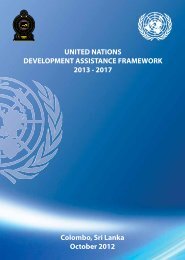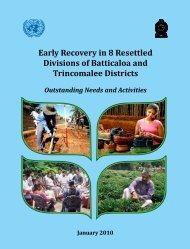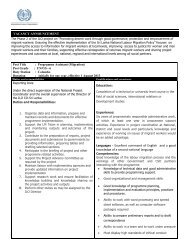Sri Lanka Human Development Report 2012.pdf
Sri Lanka Human Development Report 2012.pdf
Sri Lanka Human Development Report 2012.pdf
You also want an ePaper? Increase the reach of your titles
YUMPU automatically turns print PDFs into web optimized ePapers that Google loves.
Multidimensional poverty headcount(H) =<br />
(Number of multidimensionally poor persons)<br />
(Total population)<br />
= q n<br />
where q is the number of multidimensionally poor persons and<br />
n is the total population of the area considered in the analysis.<br />
The intensity of poverty, (A), reflects the proportion of weighted<br />
component indicators in which, on average, poor people are<br />
deprived. The deprivation scores are summed up for all the<br />
people living in the multidimensionally poor households and<br />
divided by the product of the total number of indicators and by<br />
the total number of multidimensionally (MD) poor people.<br />
kitchen’ for the DHS 2006/07 dataset. The change was done<br />
after consultations with regional experts<br />
The latest Household Income and Expenditure Survey (HIES<br />
2009-2010), conducted by the Department of Census and<br />
Statistics, has the latest data to calculate both consumption/<br />
income poverty and multidimensional poverty for 22 out of<br />
25 districts, including all three in the Eastern Province, and<br />
Jaffna and Vavuniya districts in the Northern Province. Again,<br />
∑ q i<br />
Intensity of poverty = A =<br />
c<br />
qd<br />
Sum of depreviation scores for all members in MD poor households<br />
=<br />
MD poor persons×number of indicators<br />
wherec is the total number of weighted deprivations the poor<br />
experience and d is the total number of component indicators<br />
considered (in this case 10).<br />
The MPI = MD poor population ×intensity of poverty=HA.<br />
The MPI represents the share of the population that is<br />
multidimensionally poor.<br />
The Datasets<br />
Micro-data from two national surveys, conducted by the<br />
Department of Census and Statistics, were used to calculate the<br />
MPI and related indices for <strong>Sri</strong> <strong>Lanka</strong>. The Demographic and<br />
Health Survey 2006/07 (DHS 2006-2007) provided all data<br />
to compute the MPI and related indices down to the district<br />
level. DHS2006/07 does not cover the districts in the Northern<br />
Province, however, and is somewhat dated. It also does not<br />
contain all standard indicators necessary to calculate the MPI.<br />
In particular, standard indicator nine, ‘household uses firewood<br />
as cooking fuel, but does not have a separate kitchen’, has been<br />
modified. Since around 80 percent of the households in <strong>Sri</strong><br />
<strong>Lanka</strong> use firewood for cooking, this indicator was changed<br />
to ‘household uses firewood as cooking fuel but no separate<br />
however, it does not contain all of the standard indicators<br />
required for the MPI. For example, the Household Income<br />
and Expenditure Surveys do not usually provide the necessary<br />
data to compute the two health indicators shown in Table T.4.<br />
Because of the importance of the health dimension, two suitable<br />
proxy indicators were used.<br />
The DHS 2006-2007 and HIES 2009-2010 datasets are not<br />
directly comparable: They share seven common indicators, but<br />
differ on three. An attempt was made to compare the health<br />
dimensions of the MPI derived from the two datasets, since<br />
health is fundamental to multidimensional poverty in <strong>Sri</strong> <strong>Lanka</strong>.<br />
If <strong>Sri</strong> <strong>Lanka</strong> considers the MPI sufficiently important, it may<br />
wish to include the relevant indicators in future surveys.<br />
Multidimensional Poverty Based on DHS<br />
2006/07<br />
The multidimensional poverty headcount for <strong>Sri</strong> <strong>Lanka</strong>,<br />
excluding the Northern Province and based on DHS 2006-<br />
2007, was seven percent. This was less than half the income<br />
poverty headcount based on HIES 2006/07 (Figure T.1 and<br />
Table A4). The MPI for <strong>Sri</strong> <strong>Lanka</strong> in 2006-2007 was 0.0278;<br />
per UNDP 2010, it was 0.021.<br />
172<br />
sri lanka <strong>Human</strong> <strong>Development</strong> report 2012






